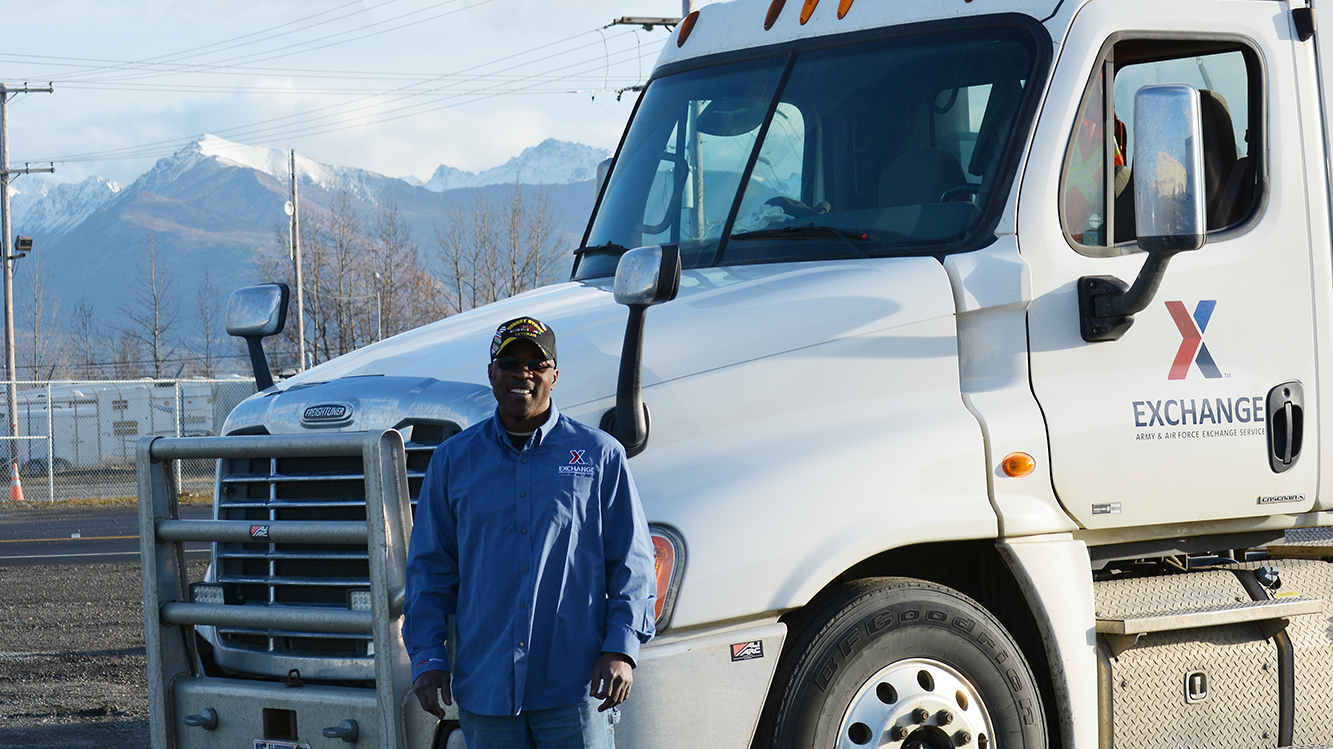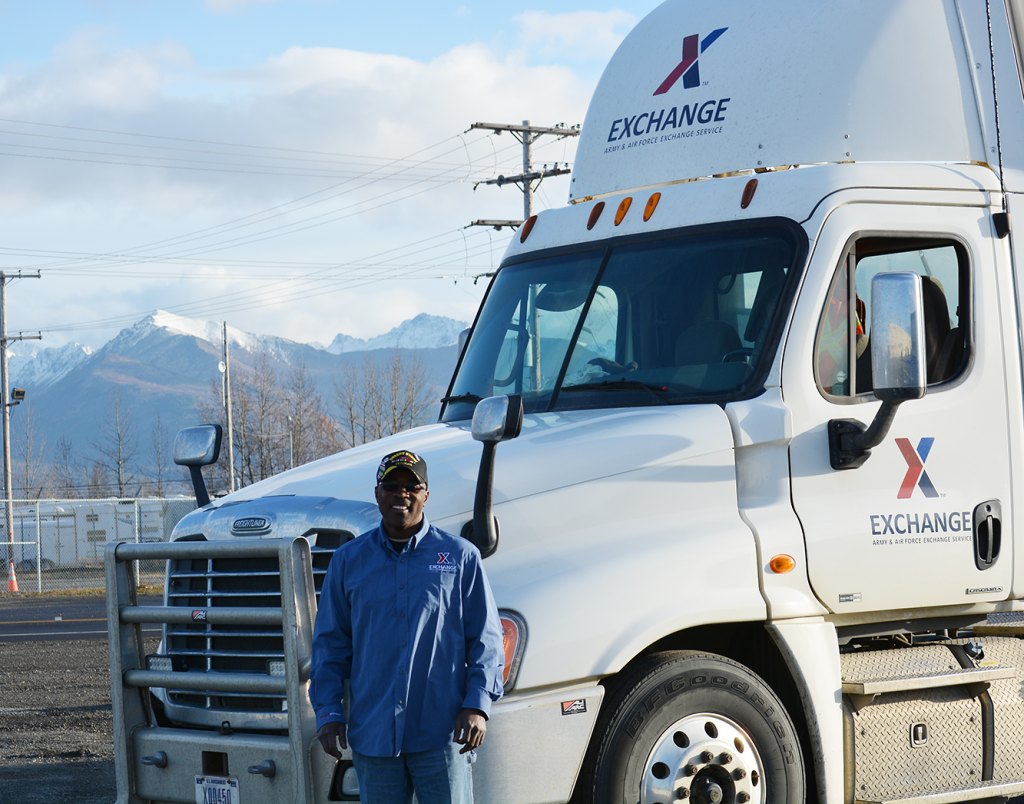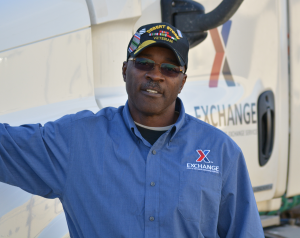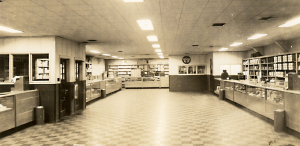The Exchange’s Ice Road Trucker: Neither Moose Nor Caribou Can Stop Him


Amos Jeffery, his rig and majestic Alaskan mountains.
Amos Jeffery is the Exchange’s ice road trucker and one brave—and incredibly safe—soul.
Neither moose nor 3 feet of snow can stop the Exchange’s only trucker in Alaska from delivering goods from Joint Base Elmendorf-Fort Richardson in the south to Fort Wainwright in the north.
Jeffery runs his Freightliner Cascadia and 53-foot trailer nearly 400 miles one way, averaging about 12,000 miles a year from his Elmendorf-Richardson base.
Drives 12,000 miles a year
He just passed the half-million mile mark as he enters his ninth year of driving for the Exchange.
“When I first started driving for the Exchange, I was running this route each week, averaging about 1,000 miles,” Jeffery said. “I’ve gone from four times a month to twice a month and now once a month. I went from 50,000 miles a year for the first five years, then 25,000 miles twice a month for two years and now 12,000 miles for this year.”
When he’s not on the road, he helps in the warehouse at JB Elmendorf with routine operations; moving fixtures to and from local facilities; helping unload incoming freight trailers; ensuring Sears deliveries are prepared, staged and ready for pickup; helping customers with furniture orders; hauling cardboard to the recycling center; sorting pallets for reuse; among a laundry list of other chores.
Safety is number one
His boss, JB Elmendorf-Richardson Exchange General Manager Raymond Stewart, said he can count on Jeffery to get the goods where they need to go.
“He’s a dedicated and great associate,” Stewart said. “He solves for ‘yes,’ doesn’t make the trip if not needed, and I can count on him to deliver the merchandise while being safe during the winter months.
“Safety is No. 1 with him. He takes care of his rig, and knows the importance of getting the goods up north safely.”

Jeffery said he is one safe driver, despite the harsh road conditions in Alaska.
During Jeffery’s treks through the wilderness, he has encountered moose, caribou, bears and porcupines that don’t mind crossing the road right in front of his truck. What’s more, tourists don’t mind stopping in the middle of the road or hidden around a curve or just over a hilltop to snap pictures of the natural beauty.
Tire chains, winter-driving kit
And, oh, the winters. But Jeffery isn’t one to tempt fate. He said he’ll pull his rig over or get some place safe if the weather gets too dangerous to drive.
“The beginning and end of winter are the worst times to be traveling, especially when there’s nothing or no one for a 100-mile stretch of highway,” Jeffery said. “The snow melts when the sun hits it, but as soon as the sun goes down, the snow all freezes.”
Wet, heavy snow sticks to windshields and everything on the truck—from all the fluids to the brakes—freezes when temperatures plunge to 40 to 60 degrees below zero. Ambulances and police could take up to four hours to get to a wreck between Anchorage and Fairbanks, where the only roads are two laners with very few passing areas and no safety rails.
“Tire chains are a must here and so is a winter driving kit, with extra-warm clothing, batteries, some form of heater, gloves, emergency flares,” he said. “If your truck breaks down and the temperature is 40 below, you’ll experience frostbite and hypothermia in about an hour.”
‘I was one of them’
Jeffery drove trucks after joining the Army in 1986. He served in both Gulf Wars, and later drove 18-wheelers full of medical supplies to hospitals throughout Europe and hauled ammunition and vehicles to port after military bases began closing. He retired with 22 years of service from Fort Bragg, N.C.
But neither Europe’s hairpin curves nor Iraq’s makeshift roads lined with snipers and sand could prepare him for Alaska.
“I drive in snow for eight months of the year, but when you have the world’s Army and Air Force customers counting on you, the job of getting the products to them is so much easier,” Jeffery said. “I know what they’re going through because I was once one of them.”

The PX at Fort Richardson, early 1950s. From the Exchange History Archives on Flickr.
HISTORY FUNFACT
June 27, 1940
The day the first post exchange opened for American troops who had just arrived in Anchorage, Alaska, for a new military installation later named Fort Richardson. By 1942, PXs were located in at least 15 military camps, from the Aleutian Islands south of Alaska to isolated wilderness of the north.

